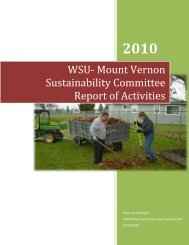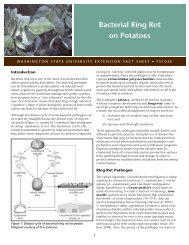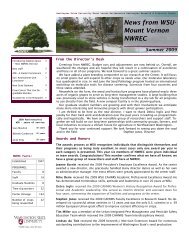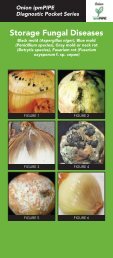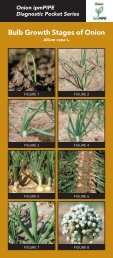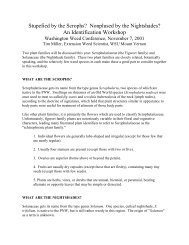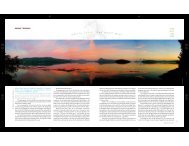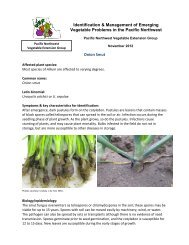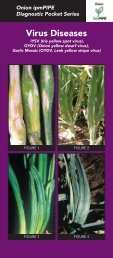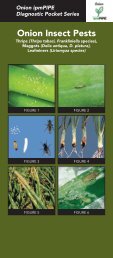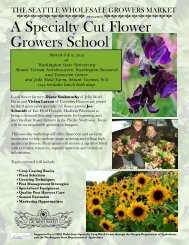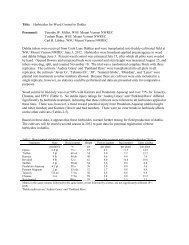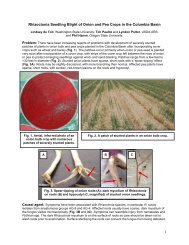Fusarium & Verticillium Wilts in Spinach - WSU Mount Vernon ...
Fusarium & Verticillium Wilts in Spinach - WSU Mount Vernon ...
Fusarium & Verticillium Wilts in Spinach - WSU Mount Vernon ...
Create successful ePaper yourself
Turn your PDF publications into a flip-book with our unique Google optimized e-Paper software.
<strong>Fusarium</strong> & <strong>Verticillium</strong> <strong>Wilts</strong><strong>in</strong> Sp<strong>in</strong>ach: Research UpdateWilbur-Ellis/Alf Christianson Seed Co. Seed Growers’ Mtg6 February 2013, Burl<strong>in</strong>gton, WAL<strong>in</strong>dsey du Toit, Mike Derie, Emily Gatch, & Barbara Holmes<strong>WSU</strong> <strong>Mount</strong> <strong>Vernon</strong> NWREC
Emily Gatch’s PhD Research Objectives1. Assess potential for enhanc<strong>in</strong>g suppression of <strong>Fusarium</strong>wilt us<strong>in</strong>g annual applications of limestone and nitrate-Nfertilizers, and the effects of limestone on <strong>Verticillium</strong>dahliae.2. Develop a soil bioassay for sp<strong>in</strong>ach seed growers todeterm<strong>in</strong>e the relative risk of a field for <strong>Fusarium</strong> wilt,us<strong>in</strong>g sp<strong>in</strong>ach parent l<strong>in</strong>es with different levels ofresistance.3. Determ<strong>in</strong>e the effects of micronutrients and pH on F.oxysporum f. sp. sp<strong>in</strong>aciae and host-pathogen<strong>in</strong>teractions.
Rep 1Rep 2NH 4 NO 3 NO 3 NH 42009 Field TrialRep 3NO 3 NH 4Rep 4NH 4 NO 3Rep 5NO 3 NH 42 tons limestone0 tons1 ton0 tons2 tons1 ton limestone1 ton0 tons2 tons1 tonS R M S R MO tons limestoneR M S R M S M R S M R S2 tons2 tonsR S M R S M1 tonS M R S M R0 tons
2009 2010 2011 2012sp<strong>in</strong>ach potato w<strong>in</strong>ter wheat sp<strong>in</strong>achLimestone applications
2012 Field TrialRep 1 Rep 2 Rep 3 Rep 4Rep 5Prol<strong>in</strong>e2 tons limestone0 tons1 ton0 tons2 tonsProl<strong>in</strong>eProl<strong>in</strong>eProl<strong>in</strong>e1 ton limestone1 ton0 tons2 tons1 tonProl<strong>in</strong>eS M R S M R0 tons limestoneM R S M R S R M S R M S2 tons2 tonsM S R M S R1 tonS R M S R M0 tons
2 tons limestone/acre each year1 ton limestone/acre each year0 tons limestone/acre each year0 tons limestone/acre each year+ 2 tons/acre <strong>in</strong> spr<strong>in</strong>g 2012
Soil pHEffect of limestone rate on soil pH: 2009-20128.07.06.05.00120/24.02009 2010 2011 2012sp<strong>in</strong>ach potato w<strong>in</strong>ter wheat sp<strong>in</strong>achLimestone applications
Soil pHEffect of limestone rate on soil pH: 2009-20128.07.06.05.00120/24.02009 2010 2011 2012sp<strong>in</strong>ach potato w<strong>in</strong>ter wheat sp<strong>in</strong>achLimestone applications
Soil pHEffect of limestone rate on soil pH: 2009-20128.07.06.05.00120/24.02009 2010 2011 2012sp<strong>in</strong>ach potato w<strong>in</strong>ter wheat sp<strong>in</strong>achLimestone applications
Soil pHEffect of limestone rate on soil pH: 2009-20128.07.06.05.00120/24.02009 2010 2011 2012sp<strong>in</strong>ach potato w<strong>in</strong>ter wheat sp<strong>in</strong>achLimestone applications
Incidence of wilt (%)Wilt <strong>in</strong>cidence1008024 June 2009SusceptibleModerateResistant19 June 201260Male402000 1 20x4 1x4 2x4 0-0-0-2Limestone rate (t/A)
Incidence of wilt (%)Wilt <strong>in</strong>cidence10014 July 20099 July 2012806040200SusceptibleModerateResistantMale0 1 20x4 1x4 2x4 0-0-0-2Limestone rate (t/A)
Severity of wilt (0 to 5 scale)Wilt severity5439 July 2012 31July 2012SusceptibleModerateResistantMale2100 1 20x4 1x4 2x4 0-0-0-2Limestone rate (t/A)
Dried plant weight (g)Sp<strong>in</strong>ach biomass (dry plant weight)250Susceptible22 July 2009 11 July 2012200150ModerateResistantMale1005000 1 20x4 1x4 2x4 0-0-0-2Limestone rate (t/A)
Seed yield (lb/A)Seed yield1600Susceptible2009 20121200Moderate800Resistant40000 1 20x4 1x4 2x4 0-0-0-2Limestone rate (t/A)
<strong>Fusarium</strong>-<strong>in</strong>fected seed (%)Harvested seed (%) <strong>in</strong>fected with <strong>Fusarium</strong>252009 20122015SusceptibleModerateResistant10500 1 2Limestone rate (t/A)0x4 1x4 2x4 0-0-0-2
V. dahliae <strong>in</strong>fected seed (%)Harvested seed (%) <strong>in</strong>fected with <strong>Verticillium</strong> dahliae252009 20122015SusceptibleModerateResistantMale10500 1 20x4 1x4 2x4 0-0-0-2Limestone rate (t/A)
2. Develop a soil bioassay for sp<strong>in</strong>ach seed growers todeterm<strong>in</strong>e the relative risk of a field site for <strong>Fusarium</strong>wilt, us<strong>in</strong>g sp<strong>in</strong>ach l<strong>in</strong>es with different levels ofresistance.- Wilt rat<strong>in</strong>gsResearch Objectives- Sp<strong>in</strong>ach biomass- Quantify F. oxysporum and V. dahliae on selective media- Soil nutrient analyses: macro & micronutrients, pH, OM, CEC- Texture analysis- # of years out of sp<strong>in</strong>ach seed crops- Quantify F. oxysporum f. sp. sp<strong>in</strong>aciae with a real-time PCRassay
2009-10: 26 soils submitted2010-11: 42 soils submitted2011-12: 39 soils submitted2012-13: 40 soils submittedControl soils <strong>in</strong>cluded each year:Low (no), medium, and high <strong>Fusarium</strong> wilt risk
RSoil AMSoil CSRMRSMSSoil B
<strong>Fusarium</strong> wilt <strong>in</strong>dexRisk assessment: Sp<strong>in</strong>ach <strong>Fusarium</strong> wilt soil bioassayPartially resistant l<strong>in</strong>e Moderately-susceptible l<strong>in</strong>e Susceptible l<strong>in</strong>eA. 2009-10 bioassayField (soil) sampleB. 2010-11 bioassayField (soil) sample
Risk assessment: Sp<strong>in</strong>ach <strong>Fusarium</strong> wilt soil bioassayPartially resistant l<strong>in</strong>e Moderately-susceptible l<strong>in</strong>e Susceptible l<strong>in</strong>eC. 2011-12 bioassayField (soil) sample
Bioassay validation
AcknowledgementsPuget Sound Seed Growers’ AssociationWash<strong>in</strong>gton State Commission for Pesticide RegistrationAlfred Christianson Family Endowment, Robert MacDonald FundUSDA Western Region IPM, Western SAREParticipat<strong>in</strong>g growers and seed companiesTodd GordonDan Nelson, Russ DuckworthMike Derie, Barbara Holmes,Avi Alcala,Sarah Meagher,Ron Dralle, Jonathan Roozen,Martha Sudermann,John Kuhn, Anita da Costa,Shawn Watk<strong>in</strong>son, Tammy Ennen,Nathan McCartney, Tyler VanderPol
Evaluation of Prol<strong>in</strong>e for Management of<strong>Fusarium</strong> Wilt <strong>in</strong> Sp<strong>in</strong>ach Seed Crops
Prol<strong>in</strong>e and <strong>Fusarium</strong> <strong>Wilts</strong>Prol<strong>in</strong>e 480 SC = prothioconazole (triazole, Group 3)Sp<strong>in</strong>ach seed crops <strong>in</strong> DK: empirical observations?Transplanted watermelon <strong>Fusarium</strong> wilt: drench, drip trialsZhou & Everts. 2009. PDMR 3:V092; Zhou et al. 2010. PDMR 4:V065Everts et al. 2011. Phytopathology 101:S50-S51 (Abstract)120100806040200eabcabcdbcdaedbaeabcdcdbcabca abbcdaabcdebc cd cd• 3 drenchapplications• 2-week<strong>in</strong>tervals fromtransplant<strong>in</strong>gWilt <strong>in</strong>cidence 17 JulPlot vigor 7 AugYield (kg/plot)
2012 Sp<strong>in</strong>ach Seed Crop <strong>Fusarium</strong> Wilt Field TrialRep 1 Rep 2 Rep 3 Rep 4Rep 5Prol<strong>in</strong>e2 tons limestone0 tons1 ton0 tons2 tonsProl<strong>in</strong>eProl<strong>in</strong>eProl<strong>in</strong>e1 ton limestone1 ton0 tons2 tons1 tonProl<strong>in</strong>eS M R S M R0 tons limestoneM R S M R S R M S R M S2 tons2 tonsM S R M S R1 tonS R M S R M0 tons
Banded Prol<strong>in</strong>e applications (CO 2 -backpack sprayer)10 May = 2 days after plant<strong>in</strong>g sp<strong>in</strong>ach31 May = 3 weeks after plant<strong>in</strong>g21 June = 6 weeks after plant<strong>in</strong>g
Severity of wilt (0 to 5 scale)Severity of wilt (0 to 5 scale)Effect of Prol<strong>in</strong>e on severity of wilt54Prol<strong>in</strong>eNo Prol<strong>in</strong>e54Prol<strong>in</strong>eNo Prol<strong>in</strong>e* 5.1% * 8.2%* 6.3%33221109 July 31 JulyWilt assessment date0Susceptible Moderate ResistantSp<strong>in</strong>ach <strong>in</strong>bred l<strong>in</strong>e* Denotes significant difference between Prol<strong>in</strong>e vs. no Prol<strong>in</strong>e plots at P
Seed yield (lb/acre)Effect of Prol<strong>in</strong>e on seed yield15001000500Prol<strong>in</strong>eNo Prol<strong>in</strong>e* 18.4% * 11.4% 6.9%0Susceptible Moderate ResistantSp<strong>in</strong>ach <strong>in</strong>bred l<strong>in</strong>e* Denotes significant difference between Prol<strong>in</strong>e vs. no Prol<strong>in</strong>e at P
Incidence of seed with <strong>Fusarium</strong> (%)Incidence of seed with <strong>Verticillium</strong> (%)Effect of Prol<strong>in</strong>e on <strong>in</strong>cidence of harvested seed<strong>in</strong>fected with <strong>Fusarium</strong> and <strong>Verticillium</strong>10<strong>Fusarium</strong>Prol<strong>in</strong>e15<strong>Verticillium</strong>Prol<strong>in</strong>e8No Prol<strong>in</strong>eNo Prol<strong>in</strong>e6104520Susceptible Moderate Resistant0Susceptible Moderate ResistantSp<strong>in</strong>ach <strong>in</strong>bred l<strong>in</strong>eSp<strong>in</strong>ach <strong>in</strong>bred l<strong>in</strong>e
2013 Sp<strong>in</strong>ach Seed Crop <strong>Fusarium</strong> WiltProl<strong>in</strong>e Field Trial• Field: acid soil, sp<strong>in</strong>ach seed crop last 4-5 yrs,proximity to NWREC• Treatments:• Prol<strong>in</strong>e vs. no Prol<strong>in</strong>e• 3 female sp<strong>in</strong>ach <strong>in</strong>bred l<strong>in</strong>es (S, M, R)• 2 tons limestone/acre (all plots)• Apron + Thiram + Tops<strong>in</strong> seed treatment• Prol<strong>in</strong>e applications:• Method: In-furrow drench + banded soil applications• Number: 3 = maximum (sugar beet)• Interval: 14-21 days
2013 Sp<strong>in</strong>ach <strong>Fusarium</strong> WiltProl<strong>in</strong>e Field TrialSuggestions? Questions?dutoit@wsu.edu or 360-848-6140
Management of <strong>Verticillium</strong><strong>in</strong> Sp<strong>in</strong>achL<strong>in</strong>dsey du Toit & Mike Derie, Wash<strong>in</strong>gton State UniversityJim Correll, University of Arkansas
<strong>Verticillium</strong> associated with sp<strong>in</strong>ach seed1. Prevalence of<strong>Verticillium</strong> <strong>in</strong>commercial sp<strong>in</strong>achseed lots (90% of lotstested: US, EU, NZ,Chile)2. Pathogenicity of seedisolates to sp<strong>in</strong>ach3. Seed-to-seedtransmissionPlant Disease 89:4-11Plant Disease 89:1305-1312PDMR 1:ST003; PDMR 3:ST020;PDMR 4:ST038
Sp<strong>in</strong>ach/lettuce connection?S. T. Koike?S. T. KoikeAtallah et al. 2010. Fungal Genetics & Biology.Gene flow among V. dahliae isolates from CA lettuce, pepper, strawberry,artichoke & weeds, sp<strong>in</strong>ach seed, & WI ornamentals (not tomato)Relative significance of <strong>in</strong>fested sp<strong>in</strong>ach seed?
Evaluation of sp<strong>in</strong>ach seed treatmentsA. Hot water & chlor<strong>in</strong>e (du Toit & Hernandez-Perez, 2005.Plant Disease 89:1305-1312)B. Efficacy of sp<strong>in</strong>ach seed treatments for manag<strong>in</strong>gseedborne <strong>Verticillium</strong> (du Toit et al., 2009. PDMR 3:ST020,du Toit et al., 2010. PDMR 4:ST038)1. Reduce <strong>in</strong>cidence of seed<strong>in</strong>fected/<strong>in</strong>fested2. Reduce rate of seedtransmission3. Reduce rate of soil<strong>in</strong>festation from plant<strong>in</strong>g<strong>in</strong>fested seedC. Influence of soil fumigation
% seed with <strong>Verticillium</strong> dahliaeGH Trials: % Seeds with <strong>Verticillium</strong> - Trial 170605040302010aaababcbccdConventionalOrganicd deefef efg fggh0ControlACX802ACX801Coronet 200 mlVortexCoronet 400 mlACX804Exp. IIncotec IACX803Incotec II(du Toit et al., 2009. Plant Dis. Mgmt. Reports 3:ST020)Exp. IICaptan 400CThiram 42-SSeed Support Ihi ij kl ij kl lSeed Support IISeedgardBAS 595 XGFMertect 340FFarm.D300+MertectlTops<strong>in</strong> M70WP
CFUs V. dahliae /100 seedl<strong>in</strong>gs140000120000100000GH Trials: Seed transmission assay - Trial 2800006000040000200000abControlACX802Not evaluatedACX801Coronet 200 mlVortexCoronet 400 ml(du Toit et al. 2010. PDMR 4:ST038)acdACX804eExp. IIncotec IACX803bcIncotec IIabExp. IIabCaptan 400CcdThiram 42-SConventionalOrganicSeed Support IcdSeed Support IIdSeedgardef fgh eBAS 595 XGFMertect 340FFarm.D300+MertecthTops<strong>in</strong> M70WPghTops<strong>in</strong> 4.5FLControl, soilefgControl, pastzd soil
Influence of soil fumigation/pH on <strong>Verticillium</strong>seed transmission & soil <strong>in</strong>festation2010 WA field trial of baby leaf sp<strong>in</strong>ach & head lettuce1. Ma<strong>in</strong> plots:MeBr:Chloropicr<strong>in</strong> (57:43% at 350 gpa)No soil fumigation2. Split plots:Acid soil pH (~5.7-5.9)5 tons limestone/ha (pH 6.6-6.8)3. Sp<strong>in</strong>ach split-split plots:No sp<strong>in</strong>ach seedBaby leaf sp<strong>in</strong>ach: No seed treatmentBaby leaf sp<strong>in</strong>ach: Apron + ThiramBaby leaf sp<strong>in</strong>ach: Apron + Thiram + Tops<strong>in</strong> 4.5 FLBaby leaf sp<strong>in</strong>ach: Farmore D300 + Mertect 340FFollowed by head lettuce <strong>in</strong> each plot (‘Sal<strong>in</strong>as’ type)
1 June 201014 June 2010
2011 & 2012 Field trials<strong>Mount</strong> <strong>Vernon</strong>, WA (2011) & Sal<strong>in</strong>as, CA (2011, 2012)Baby leaf sp<strong>in</strong>ach & head lettuce, RCBD, 5 reps1. Ma<strong>in</strong> plots:Fumigated vs. non-fumigated2. Sp<strong>in</strong>ach split plots:No sp<strong>in</strong>achNon-treated seedApron + ThiramFarmore D300 + Mertect 340FApron + Thiram + Tops<strong>in</strong> 4.5 FL (WA 2011)Seed Support (WA 2011)ProGro (WA & CA, 2011), ProGro + Apron (CA, 2012)Followed by head lettuce <strong>in</strong> each plot
Sal<strong>in</strong>as, CA: 2011 & 2012Ocean Mist Farms (2011)Christensen & Giann<strong>in</strong>i (2012)New FreshSchafer Ag ServicesHoladay SeedsGerma<strong>in</strong>’s Technology GroupRachel Yim Bobby Eugenia
<strong>Mount</strong> <strong>Vernon</strong>, WA: 2010, 2011Effect of seed treatment & soil fumigation onseed transmission of V. dahliaeCFUs V. dahliae/100 sp<strong>in</strong>ach plants after harvest of leavesSignificant fumigation & seed treatment effects
Height (mm) of sp<strong>in</strong>ach plantson 16 June 2011<strong>Mount</strong> <strong>Vernon</strong>, WA: 2011Effect of seed treatment on sp<strong>in</strong>ach plant height1412108642abcbcabcdaNon-treated seedApron+ThiramApron+Thiram+Tops<strong>in</strong>FarmoreD300+MertectProGroSeed Support0Soil fumigation treatment
<strong>Mount</strong> <strong>Vernon</strong>, WA: 2010, 2011% of lettuce stems <strong>in</strong>fected with V. dahliae at harvestNo significant seed treatment or fumigation effects,& no symptoms of <strong>Verticillium</strong> wilt on lettuce.
<strong>Mount</strong> <strong>Vernon</strong>, WA: 2010, 2011CFU of V. dahliae <strong>in</strong> soil at sp<strong>in</strong>ach plant<strong>in</strong>gSignificant fumigation effect, but no seed treatment effect
<strong>Mount</strong> <strong>Vernon</strong>, WA: 2010, 2011CFU of V. dahliae <strong>in</strong> soil at lettuce plant<strong>in</strong>gSignificant fumigation & seed treatment effects <strong>in</strong> 2010,significant seed treatment effects <strong>in</strong> 2011.
<strong>Mount</strong> <strong>Vernon</strong>, WA: 2010, 2011CFU of V. dahliae <strong>in</strong> soil 2-5 weeks after harvest oflettuce & <strong>in</strong>corporation of lettuce residuesNo significant fumigation or seed treatment effects <strong>in</strong> 2010.
Sal<strong>in</strong>as, CA: 2011, 2012Effect of seed treatment & soil fumigation onseed transmission of V. dahliaeCFUs V. dahliae/100 sp<strong>in</strong>ach plants after harvest of leavesSignificant seed treatment effects,no significant fumigation effects
Sal<strong>in</strong>as, CA: 2011, 2012% of lettuce stems <strong>in</strong>fected with V. dahliae at harvestNo significant seed treatment or fumigation effects,& no symptoms of <strong>Verticillium</strong> wilt on lettuce plants.
Sal<strong>in</strong>as, CA: 2011, 2012CFU of V. dahliae <strong>in</strong> soil at sp<strong>in</strong>ach plant<strong>in</strong>gNo significant fumigation or seed treatment effects
Sal<strong>in</strong>as, CA: 2011, 2012CFU of V. dahliae <strong>in</strong> soil at lettuce plant<strong>in</strong>gNo significant fumigation or seed treatment effects
Sal<strong>in</strong>as, CA: 2010, 2011CFU of V. dahliae <strong>in</strong> soil 2-5 weeks after harvest oflettuce & <strong>in</strong>corporation of lettuce residuesNo significant fumigation or seed treatment effects
Summary• Soil fumigation <strong>in</strong>creased colonization of sp<strong>in</strong>ach plantsby V. dahliae 7-fold <strong>in</strong> 2010 <strong>in</strong> WA & 3-fold <strong>in</strong> 2012 <strong>in</strong> CA(not <strong>in</strong> 2011 <strong>in</strong> WA or CA sites)• Seed treatments reduced seed transmission effectively<strong>in</strong> all 4 trials• Best seed treatments = not plant<strong>in</strong>g sp<strong>in</strong>ach seed• Mertect 340F: federal registration spr<strong>in</strong>g 2014• Rancona Sp<strong>in</strong>ach (ipconazole): registered Jan. 2013• Tops<strong>in</strong> M 70WP: SLN sp<strong>in</strong>ach stock seed <strong>in</strong> WA• Plant<strong>in</strong>g <strong>in</strong>fested sp<strong>in</strong>ach seed did not result <strong>in</strong><strong>Verticillium</strong> wilt <strong>in</strong> head lettuce <strong>in</strong> all 4 trials, & had nosignificant effect on soilborne V. dahliae detected 2-5weeks after <strong>in</strong>corporat<strong>in</strong>g lettuce residues
Characterization of <strong>Verticillium</strong> dahliae fromsp<strong>in</strong>ach seed, and screen<strong>in</strong>g for resistance to<strong>Verticillium</strong> wilt <strong>in</strong> sp<strong>in</strong>ach.Villarroel-Zeballos, M.I., Feng, C., Iglesias, A., du Toit, L.J., & Correll, J.C. 2012.HortScience 47:1297–1303.Pathogenicity, virulence, &vegetative compatibility group<strong>in</strong>g of<strong>Verticillium</strong> isolates from sp<strong>in</strong>ach seedIglesias-Garcia, A.M., Villarroel-Zeballos, M.I., Feng, C., du Toit, L.J.,& Correll, J.C. 201_.Plant Disease: submitted January 2013.
AcknowledgementsAmerican Seed Research Foundation of ASTAPuget Sound Seed Growers’ Assoc.WA State Comm. for Pesticide RegistrationCA Leafy Greens Research BoardAlfred Christianson EndowmentParticipat<strong>in</strong>g seed & chemical companiesInternational Seed Health Initiative – Root, Bulb & Leafy VegetableInternational Technical GroupMike Derie, Barbara Holmes,Emily Gatch, Ana Vida Alcala, Ron Dralle, others …Angela Iglesias-Garcia (MS), Maria Villarroel-Zeballos (MS)
Incidence of wilt (%)Wilt <strong>in</strong>cidence100804 June 2009 29 May 2012SusceptibleModerate60ResistantMale402000 1 20x4 1x4 2x4 0-0-0-2Limestone rate (t/A)



